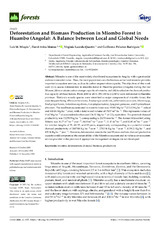Mostrar el registro sencillo del ítem
Deforestation and Biomass Production in Miombo Forest in Huambo (Angola): A Balance between Local and Global Needs
| dc.contributor.author | Miapia, Luis M. | |
| dc.contributor.author | Ariza-Mateos, David | |
| dc.contributor.author | Lacerda-Quartín, Virgínia | |
| dc.contributor.author | Palacios Rodríguez, Guillermo | |
| dc.date.accessioned | 2021-11-16T12:52:24Z | |
| dc.date.available | 2021-11-16T12:52:24Z | |
| dc.date.issued | 2021 | |
| dc.identifier.uri | http://hdl.handle.net/10396/22126 | |
| dc.description.abstract | Miombo is one of the most widely distributed ecosystems in Angola, with a great social and environmental value. Thus, the rural population uses the biomass as fuel and miombo provides important ecosystem services, such as its carbon sequestration capacity. The objectives of this work were (i) to assess deforestation in miombo forest in Huambo province (Angola) during the last 20 years, (ii) to evaluate carbon storage capacity of miombo, and (iii) to calculate the charcoal productive capacity of those forests. From 2000 to 2019, 359,130 ha (12.96%) were deforested in Huambo province. Thirty-six woody species were identified as major components of miombo forest, the most frequent being Albizia anthunesiana, Brachystegia spiciformis, Julbernardia paniculata, Monote spp., Brachystegia boemii, Isoberlinea angolensis, Anisophyllea boehmii, Syzygium guineense, and Erythrophleum africanum. The total biomass estimated in miombo forest was 195.05 Mg ha−1 (55.02 Mg ha−1 radical and 140.04 Mg ha−1 area), with a total wood volume of 78.57 m3 ha−1. This represents values of 91.67 Mg ha−1 of accumulated carbon and 336.13 Mg ha−1 of CO2 equivalent. The potential charcoal productivity was 15,359.9 kg ha−1, corresponding to 24.78 trees ha−1. The Annual Allowable Cutting Volume was 10.77 m3 ha−1 year−1, 14.13 m3 ha−1 year−1, 21.17 m3 ha−1, and 32.85 m3 ha−1 year−1 for rotation lengths of 55, 40, 25, and 15 years, respectively, corresponding to a potential annual charcoal productivity of 2107.08 Kg ha−1 year−1, 2762.96 Kg ha−1 year−1, 4139.21 Kg ha−1, and 422.56 Kg ha−1 year−1. However, deforestation rates in the last 19 years and low charcoal productive capacity could compromise the sustainability of the Miombo ecosystem and its value as an ecosystem service provider in the province if appropriate management strategies are not developed. | es_ES |
| dc.format.mimetype | application/pdf | es_ES |
| dc.language.iso | eng | es_ES |
| dc.publisher | MDPI | es_ES |
| dc.rights | https://creativecommons.org/licenses/by/4.0/ | es_ES |
| dc.source | Forests 12(11), 1557 (2021) | es_ES |
| dc.subject | Miombo | es_ES |
| dc.subject | Deforestation | es_ES |
| dc.subject | Charcoal | es_ES |
| dc.subject | Biomass | es_ES |
| dc.subject | Productivity | es_ES |
| dc.title | Deforestation and Biomass Production in Miombo Forest in Huambo (Angola): A Balance between Local and Global Needs | es_ES |
| dc.type | info:eu-repo/semantics/article | es_ES |
| dc.relation.publisherversion | https://doi.org/10.3390/f12111557 | es_ES |
| dc.rights.accessRights | info:eu-repo/semantics/openAccess | es_ES |

